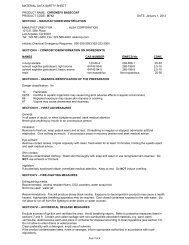Clear 4 Chrome (APC-712) MSDS - Alsa Corp
Clear 4 Chrome (APC-712) MSDS - Alsa Corp
Clear 4 Chrome (APC-712) MSDS - Alsa Corp
Create successful ePaper yourself
Turn your PDF publications into a flip-book with our unique Google optimized e-Paper software.
PRODUCT NAME: CLEAR 4 CHROMEPRODUCT CODE: <strong>APC</strong>-<strong>712</strong>MATERIAL SAFETY DATA SHEETPage 1 of 3HMIS CODES: H F R PSECTION I - MANUFACTURER IDENTIFICATIONMANUFACTURED FOR : ALSA CORPORATION2640 East 37 th StreetVernon, CA 90058Tel: (323) 581-5200Fax: (323) 589-4400Infotrac Chemical Emergency Response: (800) 535-5053 / (352)323-3500 DATE REVIEWED : December 22, 2004SECTION II - HAZARDOUS INGREDIENTS / SARA III INFORMATIONREPORTABLE COMPONENTS CAS NUMBER VAPOR PRESSUREMm Hg @ TEMPWEIGHTPERCENTToluene 108-88-3 23.8 20C 40 - 50%ACGIH TLV = 50 ppmOSHA PEL = 150 ppmethyl 3-ethoxypropionate 763-69-9 20 - 30%1-Nitropropane 108-03-2 13 20C 10 - 20%SECTION III - PHYSICAL/CHEMICAL CHARACTERISTICSBOILING RANGE: 110C - 165C SPECIFIC GRAVITY (H2O=1): .95VAPOR DENSITY: Heavier than air EVAPORATION RATE: (M - BUTYL ACETATE = 1): > 1.0COATING V.O.C.: 6.78 lb/glSOLUBILITY IN WATER: InsolubleMATERIAL V.O.C.: 6.78 lb/gl% VOLATILE by wt: 86.12%SECTION IV - FIRE AND EXPLOSION HAZARD DATAFLASH POINT: 40FMETHOD USED: Closed CupFLAMMABLE LIMITS IN AIR BY VOLUME- LOWER: n/aUPPER: n/aEXTINGUISHING MEDIA: FOAM, CO2, DRY CHEMICAL, WATER FOG, OTHER SPECIAL FIREFIGHTING PROCEDURESRespiratory equipment should be worn to avoid inhalation of concentrated vapors. Water should not be used except as fog to keep nearbycontainers cool.UNUSUAL FIRE AND EXPLOSION HAZARDSClosed containers may build explosive pressure from heat. Vapors are heavier than air and may travel a considerable distance to a sourceof ignition such as spark, pilot light, cigarette or unprotected electrical device. Not sensitive to explosion upon mechanical impact. Contactwith heat may result in pressure release from closed containers.SECTION V - REACTIVITY DATASTABILITY: StableCONDITIONS TO AVOIDExcessive heat, poor ventilation, corrosive atmospheres, excessive aging, high temperaturesCAUTION: Aluminum is present, could react with water to form H2 gas.INCOMPATIBILITY (MATERIALS TO AVOID)strong acids and oxidizing materials.HAZARDOUS DECOMPOSITION OR BYPRODUCTSCarbon monoxide, carbon dioxide, oxides of nitrogen, and possibly hydrogen chloride.HAZARDOUS POLYMERIZATION: WILL NOT OCCUR.
MATERIAL SAFETY DATA SHEETPage 2 of 3SECTION VI - HEALTH HAZARD DATAINHALATION HEALTH RISKS AND SYMPTOMS OF EXPOSUREInhalation: Dizziness, breathing difficulty, weakness, nausea, headaches & loss of coordination. Excessive inhalation of vapors may causenasal & respiratory irration.SKIN AND EYE CONTACT HEALTH RISKS AND SYMPTOMS OF EXPOSUREEye contact: Severe irritation, tearing, redness and blurred vision. Wear approved Eye Protection.SKIN ABSORPTION HEALTH RISKS AND SYMPTOMS OF EXPOSURESkin contact: Can dry and defat skin causing cracks, irritation, and dermatitis. Material may be absorbed through the skin in toxic amounts.INGESTION HEALTH RISKS AND SYMPTOMS OF EXPOSUREIngestion: Can cause gastrointestinal irritation, vomiting, nausea, and diarrhea. Aspiration of material into lungs may cause chemicalpneumonitis which can be fatal or may have systematic effects.OTHER: Routes of entry: Skin contact, eye contact, inhalation, ingestion.HEALTH HAZARDS (ACUTE AND CHRONIC)INFORMATION NOT AVAILABLE.CARCINOGENICITY:NTP CARCINOGEN: INFORMATION NOT AVAILABLE.IARC MONOGRAPHS: INFORMATION NOT AVAILABLE.OSHA REGULATED: INFORMATION NOT AVAILABLE.INFORMATION NOT AVAILABLE.MEDICAL CONDITIONS GENERALLY AGGRAVATED BY EXPOSUREINFORMATION NOT AVAILABLE.EMERGENCY AND FIRST AID PROCEDURESInhalation - Move person to fresh air. If breathing stops, apply artificial respiration and seek immediate medical attention.Eye contact - flush with large quantities of water for 15 minutes, lifting upper and lower lids. Seek medical attention.Skin contact - Wash thoroughly with soap and water and seek medical attention.Ingestion - Do not induce vomiting! Contact physician immediately.SECTION VII - PRECAUTIONS FOR SAFE HANDLING AND USESTEPS TO BE TAKEN IN CASE MATERIAL IS RELEASED OR SPILLEDEliminate all sources of ignition, provide adequate ventilation, dike spill area and add absorbent earth or sawdust to spilled liquid. Sweepup and dispose of in appropriate containers in accordance with Federal, State and/or Local regulations.WASTE DISPOSAL METHODCollect absorbent/water/spilled liquid mixture into metal containers and add enough water to cover. Seal container and label. Consult local,state & federal hazardous waste regulations before disposing into approved hazardous waste landfills. Use licenced hazardous wastedisposal agency. Obey relevant laws.PRECAUTIONS TO BE TAKEN IN HANDLING AND STORINGUse non-sparking utensils when handling this material. Avoid hot metal surface. Use in cool, well-ventilated areas. Keep containers closedwhen not in use. Keep away from excessive heat and open flames.OTHER PRECAUTIONSSmoking in area where this material is used should be strictly prohibited. Tools used with this material should be made from aluminum,brass or copper. Plastic utensils should not be used.SECTION VIII - CONTROL MEASURESRESPIRATORY PROTECTIONNo respirator needed if adequate ventilation is provided, otherwise when spraying this material use a NIOSH approved cartridge respiratoror gas mask suitable to keep airborne mists and vapor concentrations below the time weighted threshold limit values. When using in poorlyventilated and confined spaces, use a fresh-air supplying respirator or a self-contained breathing apparatus.
MATERIAL SAFETY DATA SHEETPage 3 of 3VENTILATIONGeneral mechanical ventilation or local exhaust should be suitable to keep vapor concentrations below TLV. Ventilation equip. must beexplosion proof.PROTECTIVE GLOVESImpermeable chemical handling gloves for skin protection.EYE PROTECTIONUse chemical safety glasses, goggles, and faceshields for eye protection.OTHER PROTECTIVE CLOTHING OR EQUIPMENTUse impermeable aprons and protective clothing whenever possible to prevent skin contact. The use of head caps whenever possible isstrongly recommended.WORK/HYGIENIC PRACTICESEye washes and safety showers in the workplace are recommended.SECTION IX – DISCLAIMERTo the best of our knowledge, the information contained herein is accurate, obtained from sources believed by ALSA CORPORATION tobe accurate. As with all chemicals, KEEP AWAY FROM CHILDREN AND ANIMALS. FOR INDUSTRIAL USE ONLY.












